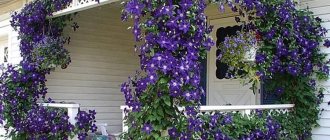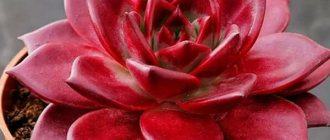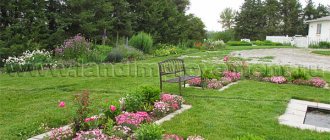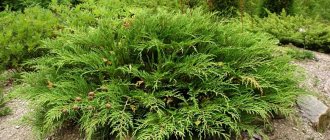The many faces and unusually beautiful clematis are a long-time love of many gardeners.
A mass of bright large flowers, shaded by lush greenery, covering buildings like an avalanche - this is what clematis looks like during the flowering period. These ornamental plants appeared relatively recently in local areas. But they managed to win the favor of flower growers with their unpretentiousness and magnificent appearance.
Pink clematis decorate an arch and can also be a great idea for wall design
Clematis bloom in spring or early summer and remain covered with flowers until autumn. After flowering ends, very decorative clematis seeds are formed on the bushes - they continue to decorate the plantings until winter.
The wall of the house is decorated with white climbing clematis
Types of clematis
Clematis come in different shapes, shades, and also with different splendor.
Star shape Source flowersguide.ru
They are also divided into 3 groups according to flowering time:
- May June . These are alpine and mountain clematis; large-petalled flowers also fall into this category.
- July August . This group includes large-flowered hybrids, such as Texene clematis. Also included in the category are small-flowered varieties, these are purple, oriental and serrate-leaved clematis.
Large-flowered hybrid Source kingdomtsvetov.rf
- The third group includes species that bloom twice a year - at the end of spring and summer . This category contains hybrid clematis, which have double flowers in June, and in August they will be completely simple.
An example of double flowers Source klumba.guru
There are also pruning rules for each group:
- The 1st group grows on the shoots of the previous year, they are cut to 0.2-0.5 m. It is important to do this immediately after flowering, this way the growth of new vines is stimulated;
Trimming shoots in parts Source flower.onego.ru
- in the 2nd group, buds grow on the shoots of the current year, so these clematis are pruned so that 0–0.3 m above ground level remains;
The photo shows where to properly trim the shoots Source doido.ru
- in the 3rd group, flowers first appear on last year's canes, and the next time they bloom on those that appeared this year.
They are only cut to half their length in the fall. Thus, flowering occurs evenly both times. To avoid exposing the lashes at the bottom, every 5 years the plant must be cut almost to the very soil.
An example of pruning each group Source orchardo.ru
Also, clematis are divided into varieties, of which there are more than 12. They can be planted with one variety or combined with several, depending on the desired result. In any case, even one species will decorate the dacha with its flowering. For example, you can plant clematis on an arch in the garden and it will decorate this passage with bright color.
Clematis on an arch Source yandex.net
Planting clematis in the garden
Before beautifully planting clematis on the site, you need to clarify a few points with the sellers. The answers to these questions will help with distribution during planting, and if used correctly, the flowers will be bright and dense when they bloom.
An example of bright flowering Source wallhere.com
When choosing a clematis variety, you need to find out what type of root system the plant has. This is necessary to know, because fibrous roots grow along the surface of the soil; such a bush is planted far from the house, fence or any other area where there will be a hard surface.
Root system Source blogspot.com
It is also necessary to know when the shoots on which the flowers develop were taken for sale. If they are last year (group A), then during pruning you need to leave them, remove them from the support and insulate them with branches of coniferous trees. For group C, you can leave 13-16 cm and several buds.
Group B, which is considered intermediate, contains flowers that form on the shoots of the previous year before summer, and on the shoots of the current year at the end of July. They must be cut to 150 cm and also covered for the winter with branches of coniferous trees.
An example of preparing a plant for winter Source maja-dacha.ru
And the last thing you need to ask the seller is how long the plant blooms. Thanks to this knowledge, you can beautifully design your garden, creating flowering from early spring to mid-autumn, while mixing several varieties.
Garden decoration by mixing several varieties Source izhevsk.ru
See also: Catalog of companies that specialize in landscape design and gardening.
Before planting, a hole is dug approximately 50 by 50 cm in size and 45 cm deep. Next, you need to fill it with fertile soil, some replace it with humus and sand, which also gives good growth to the seedling.
Planting pit Source bober.ru
At the bottom of the hole you need to make a cone of soil and spread the roots of the plant on it. Sprinkle them so that the stalk goes deeper than the neck. This way the plant will be protected when the soil subsides. If everything is done correctly, the buds will begin to develop and form shoots, which will then take root and create a new plant.
Plant shoots Source flowersinhome.ru
Clematis in the landscape design of a summer cottage
Clematis in the landscape design of a small garden will complement the summer cottage. These flowers are mainly used to decorate arches, walls, hedges and gazebos. The roots of a shrub can grow long shoots and weave around a support in a short time.
Design of a gazebo Source happymodern.ru
They are also often used for planting certain areas of land. Combinations of varieties and different colors, as well as other types of plants, can create landscape designs of amazing beauty.
Combination of varieties Source pinimg.com
Such a flower in the garden is divided into forms:
- herbaceous plant that does not need replanting;
- small and full-fledged shrubs;
- vines hanging from fences or other barriers.
A liana hangs from a fence Source agronomu.com
In the landscape design of a summer house, clematis is used in accordance with its natural form:
- Herbaceous plants are planted to decorate a flowerbed or alpine hill.
- Low-growing bushes are used to decorate low arches and a flower stand will regulate their height. Such clematis are often planted to separate areas of the garden and they grow along garden paths.
Low-growing bushes Source orchardo.ru
- Lianas, as well as tall varieties of clematis, are used to decorate arches, fences and walls. They are often planted in order to hide the unaesthetic appearance of the wall.
Creepers when decorating a home Source flower-plus.ru
Preparing for winter
With the arrival of autumn cold weather, you should take care of wintering clematis. Last year's shoots and tops are trimmed off the stems. After which they provide reliable shelter from the cold. In order for the plant to survive the winter, before insulating the shoots with leaves and twigs, it is recommended to treat the stems with antifungal agents, sprinkle with wood ash and hill up to a height of 15-20 cm.
In areas where frequent thaws are observed in winter, clematis stems are recommended to be insulated with the possibility of periodic ventilation. To do this, you can use dry weathered peat, which leaves access for air circulation. If after winter it turns out that the clematis bush has died, do not rush to uproot it. These plants are able to send out young shoots after two or three seasons. Of course, in order for the plant to come to life, it must be cared for, just like a full-fledged, healthy shoot.
Thus, clematis are an excellent means of decorating landscape design. Due to the variety of shapes and colors, unpretentiousness and resistance to temperature changes, these plants are widely used for decorative decoration of local areas. Taking into account the peculiarities of care and wintering rules for clematis, you can preserve these plants for several seasons.
Rules for growing clematis
Like any other plant, clematis requires compliance with certain rules when growing.
They need to be planted in the spring, when the soil has warmed up a little after a cold winter. If group plantings are planned, then they should be done only at a distance of 50 cm from the total mass. Tapeworms are planted 50 cm from the fence and 1 m from each other, which will allow them to fully develop.
Solitaire plants Source abekker.ru
You need to choose a place in advance and think over the composition. Also, before planting, prepare a strong support for the vine. During the germination period, you need to monitor how the plants develop and secure the branches to a support if clematis blooms on a fence or arch.
Correct fastening of branches Source pocvetam.ru
Clematis loves bright places and does not take root well in too wet soil. Wind is also harmful to him. Therefore, these conditions must be taken into account before planting. When planting a plant under a window, you need to take into account that water can pour from the roof during rain and fall on the root system, which will damage it and waterlog it. Therefore, you also need to worry about this in advance.
Roof in the rain Source pinimg.com
During planting, gardeners recommend placing drainage materials and sand in the hole. Thanks to them, the soil will not become waterlogged, and the roots will be protected from oversaturation with water.
Sand in the pit Source diz-cafe.com
It is also necessary to carry out sanitary pruning, removing damaged or diseased branches. And do not forget about pruning after flowering.
If clematis are given proper care, then in 4 years they will grow into a large bush that will need to be divided. If this is not done, the roots will become tangled and the plant will lose its appearance.
A large bush that needs to be divided Source wallpaperscraft.ru
Migrant from the subtropics
Being a native of the subtropics and tropics, clematis has fully adapted to the climate of the middle zone, which allows it to be grown in open ground. For comfortable growth, it needs sun, moisture and a place protected from the wind. Therefore, it can be planted along the walls, maintaining a distance of about half a meter from them and protecting it from water pouring from the roof. In autumn, the withered above-ground parts of the plants are cut off, the woody shoots are left to overwinter open and only the root system is covered, protecting it from frost.
Gorgeous blue clematis wrap around an outdoor light to add sophistication to a yard design.
A wide variety of species and varieties makes clematis very popular in the country. They can be used to decorate an area - grassy forms look very decorative on a green lawn or near a pond. Subshrubs will hide behind terraces, borders or low fences. Liana-like varieties can completely weave gazebos, building walls or fences, giving them a fabulous look. Pergolas, mesh or openwork elements of buildings can be used as a support for climbing clematis.
Bright roses and clematis will decorate your garden
Advice ! When growing on a support, carefully monitor whether the plant has time to gain a foothold on it. To prevent a large mass of greenery and flowers from collapsing, it should be additionally tied up.
Planting clematis with other plants
Clematis can be planted with other flowers, thus creating a beautiful composition. For example, gardeners often use lilac, rose hips, jasmine or climbing rose bushes for “neighborhood”. Low-growing plants are planted next to tall ones, which allows them to complement each other. If all shoots are planted correctly, the plants will not block each other from the sun's rays, which will allow them to grow quickly. Also, such planting is convenient because if one flower finishes blooming, it is replaced by another and the garden does not look empty for some time.
Clematis next to roses Source dizajn-sada.ru
Clematis can also be planted next to trees and other shrubs, but you need to monitor the root system of all plants so that there are no problems during growth. The flowers coexist well with coniferous trees, pear, acacia, elderberry and mackerel.
Vertical gardening
Roses in landscape design
This type of design is popular in England and European countries. There it is customary to cover the walls with a continuous carpet of ivy or wild grapes. Clematis vines will cope with this task perfectly. A green mass of leaves with flowers will hide building imperfections, unsightly areas, or simply fill empty spaces.
For the stems of climbing vines, supports are built along which the plant will climb up. A prerequisite is that the structure does not fit tightly against the wall so that the top clings freely to the frame. Growing trees are suitable as vertical support - the plants are simply planted near the trunks.
Some varieties do well in large flowerpots, so there is no need to create a flower bed under the house. For containers, medium-sized vines are taken: Alexandrite, Alyonushka, Joan of Arc, Madame von Hot, Rhapsody, Yubileiny-70.
Low-growing vines are placed in hanging flowerpots. Plants that bloom from the very roots look best here. Combining different varieties of clematis in landscape design allows you to achieve incredible results.
Caring for clematis
Since clematis are plants that live for many years, they do not tolerate repeated transplants, especially if the variety has a taproot system. Then they will be sick for a long time after moving. Therefore, it is necessary to foresee in advance the interference that may arise in the future. For example, the growth of tree roots (they can catch the flower, which will lead to its death) or the fact that the clematis root will rest against a fence or other hard surface. This can also have a negative impact on their growth.
Correct planting near the fence Source zemeljka.ru
In order for clematis to grow normally, it is necessary to water them correctly. Once every 7 days, the soil should be abundantly enriched with water around the bush, but if possible, do not direct the stream at the roots so that they do not become exposed.
Diseases and pests
Plant care includes disease prevention. Clematis are highly susceptible to fungal diseases. As a result of infection, the leaves and stems lose their elasticity and instantly wither. Some diseases are located in the soil, then the disease begins with the death of the measles system.
Flowers need to be treated with special preparations: Azacen and Fundazol, for prophylactic purposes. Photo: mtdata.ru
If you follow the correct agricultural practices, the disease will not occur, and when it does occur, it will go away instantly. When symptoms of the disease are detected, the first step is to remove the affected areas.
Preparations Fundazol or Azocene, used in diluted form under the root system, give good results in the fight against gray mold or powdery mildew.
Video description
This video tells you how to properly water and feed a flower
. Since clematis absorb many useful elements from the soil, sometimes it is necessary to fertilize them with fertilizers, which will be well reflected in the density of flowering and the general appearance of the flower. But you need to know that fresh manure and acidic peat cannot be added to the soil, this can kill the roots. Instead, you can add mineral fertilizers (for example, superphosphate) and ash to the soil.
Ash for fertilizer Source gardenreview.ru
Tricks of experienced gardeners for lush flowering.
To grow beautiful clematis, you need to be aware that they are real gluttons, they should not be fed, but fed regularly and plentifully!
- When to feed clematis. Fertilize the vine once every 10 days with small portions of fertilizer, always in liquid form. We begin fertilizing in May, when shoots begin to grow.
- What to feed:
- 1 tbsp. spoon of ammonium nitrate per 10 liters of water or
- cow manure in a ratio of 1:10, or
- bird droppings in a ratio of 1:15 or
- 2 tablespoons of vermicompost per 10 liters of water. We use one bucket of solution per bush.
- How to fertilize. Alternate mineral fertilizers with organic ones. When the buds appear, give organic and mineral fertilizers at the same time.
- We protect from pests. If the soil is acidic, to prevent wilt disease, you need to deacidify it with lime milk (200 g of lime per 10 liters of water). Ash is also suitable for these purposes.
- We strengthen the plant. These garden vines love growth stimulants - so spray them with Epin extra once every 10 days. This protects them from stress, helps them successfully survive spring frosts and makes shoots grow more actively.
Clematis in landscape design - photo
Flowers on the arch Source mykaleidoscope.ru
Flowers on the veranda Source u-florista.ru
Clematis on a pergola Source orchardo.ru
Composition near a flower bed Source my.mail.ru
Decorative arch Source flo.discus-club.ru
Living fence Source twimg.com
Flowers on the arch Source maksiolus.ru
Living fence Source idei.club
Decorative jewelry Source idei.club
Clematis on a pergola Source pinimg.com
Decorating a gazebo Source mikeharveygardens.com
Clematis on a pergola Source flo.discus-club.ru
Clematis on the fence Source maksiolus.ru
Decorative arch Source 2proraba.com
Option for a decorative arch with flowers Source na-dache.pro
Briefly about the main thing
Clematis are divided into 3 groups according to their flowering time. The first bloom at the end of spring, the second before autumn and the third twice (beginning and end of summer). All these species must be pruned after each flowering to remove excess shoots so that they grow thicker in the new season. If the shoots are not removed, the flowering will be sparse and will not cover the clearing or completely fill the required area of land.
Also, before buying a shoot for planting, you need to find out a little information about it: which group it belongs to (A, B or C), what type of root system and how long the flowering lasts. Based on these data, you can plant the flowers correctly so that they do not interfere with each other and during the flowering process they replace already faded flowers.
There are also several important rules for care: do not oversaturate with moisture, plant at a distance from each other and, as they grow, secure the shoots to a support.
In landscape design, it can be combined with other plants that will complement each other and the composition as a whole. But this planting also needs to be done according to the rules (maintain distance, correctly combine root systems and combine plants that are suitable for the flowering season). Also, they should not be placed so that they block each other from the sun.
Ratings 0
A little history
This flower appeared in Europe more than 450 years ago, but won love much later. The British were the first to fall in love with it and began to breed it, making clematis their national plant. They began to breed its first species and various varieties.
In Russia, this colorful vine was recognized at the beginning of the 19th century. It was believed that the Russian climate is very harsh for the growth of clematis, but it quickly became popular and is now found in almost any yard.











